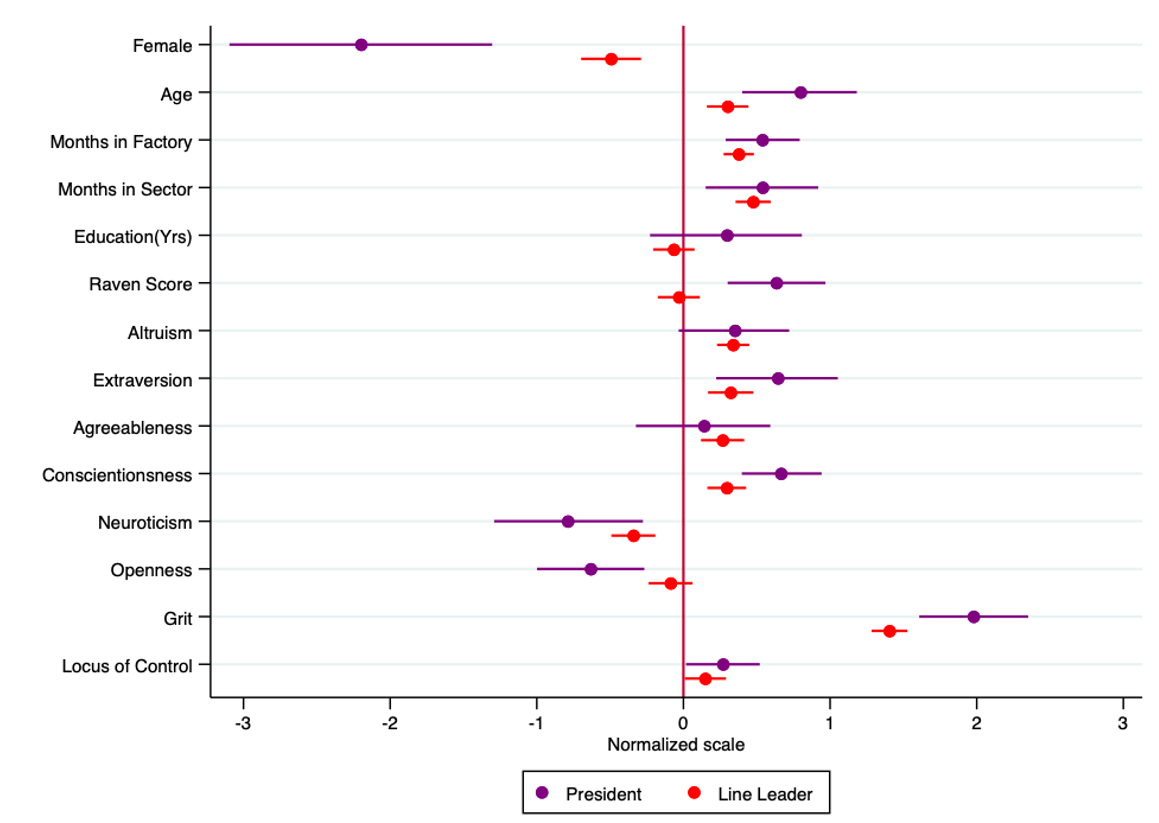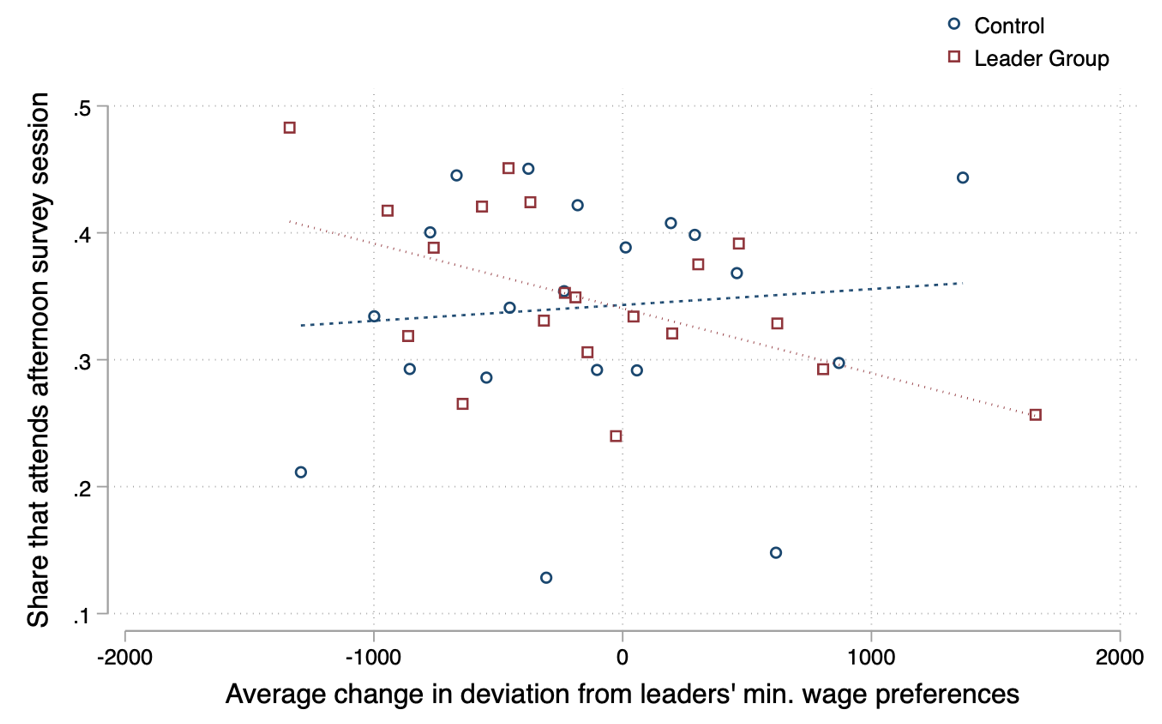
Union leaders exhibit better leadership qualities than average workers and cultivate collective action in labour movements through a coordinating role
Social movements have been catalysts for many institutional changes: the eight-hour workday movement, the suffragettes, the civil rights movements, to name but a few. To succeed, social movements must coordinate their members’ views and collective actions. Coordinating views requires building consensus around common objectives and tactics among diverse members. Once a consensus is built, coordinating actions requires mobilising members to participate in activities that have high private costs and uncertain public benefits. But unlike in organisations such as firms and bureaucracies, monetary incentives, contracts, and hierarchies are often unavailable to align views and to motivate members in social movements.
Against this backdrop, leaders may play critical roles. Economic theory suggests several ways that leaders may act as coordinators in both consensus building and mobilisation (Hermalin 1998, Caillaud and Tirole 2007, Dewan and Myatt 2008, Loeper et al. 2014).
Despite their potential importance, there is a dearth of empirical evidence on leaders’ roles in social movements. Two exceptions are Dippel and Heblich (2021) and Cagé et al. (2022), which provide evidence from different historical social movements that exposure to leaders increases participation. The lack of evidence is due to measurement and identification challenges. On the measurement side, it is difficult to observe many leaders performing the same task. On the identification side, it is difficult to distinguish if a given individual influences others (i.e. is in fact a leader) or if their behaviour is simply a more visible emblem of the underlying group dynamics - a version of the “reflection problem” (Manski 1993).
We overcome these challenges by running field experiments on union leaders in Myanmar’s burgeoning labour movement, which is broadly representative of the struggles in organising labour in newly industrialising countries (e.g. Visser et al. 2019). We collaborated with the Confederation of Trade Unions in Myanmar (CTUM), the largest confederation of labour unions at the national level, during the months preceding the revision of the national minimum wage. CTUM represented workers’ interests in the national minimum wage setting process. In the run-up to the planned May 2020 negotiations, the CTUM organised weekend sessions with workers employed in 17 garment factories with CTUM-affiliated unions to discuss the minimum wage and to gather systematic information on workers’ skills and living costs.
We helped the CTUM to organise the discussions and to conduct the surveys, which allowed us to embed multiple experiments to examine (1) whether and how union leaders build consensus around the minimum wage level and (2) whether and how they mobilise workers to participate in privately costly activities for the common good. The sessions also provided a unique opportunity to characterise the types of individuals who emerge as leaders in labour movements, adding to our scant understanding of selection into leadership roles in social movements.
Who are the union leaders?
We find that union leaders are distinct from union members and non-members along key traits that psychologists and organisational sociologists associate with the ability to influence collective outcomes (e.g. Judge et al. 2002), but that have been less examined within economics. Union presidents and union line leaders (LLs) -- who are mid-level leaders tasked with interacting with, mobilising, and gathering and channelling workers’ concerns -- are more extroverted, less neurotic, and more conscientious compared to workers. They have greater grit and locus of control. We also find that both presidents and LLs are more altruistic, and presidents have higher cognitive ability, which are two traits that economists identify as critical for political selection (Caselli and Morelli 2004, Dal Bó et al. 2017).
This is the first systematic evidence on union leaders’ characteristics and how they compare to the workers they represent. It is sometimes argued that union leaders might be negatively selected in terms of ability, as lower-ability workers stand to gain more from collective representation, but we find evidence of positive selection. Our findings also suggest that one mechanism through which leaders influence followers is their distinct set of personal characteristics.
Figure 1: Differences between Union Presidents, Union Line Leaders, and non-leaders (after standardisation)

Notes. This figure plots the estimated coefficients from regressions of the characteristic on indicators for being a union President (n=17), being a union Line Leader (n=170), and factory fixed effects. All characteristics are standardised prior to running regressions so that the variables are on the same scale. Due to the limited number of clusters (17 factories), we report 90% confidence sets calculated using the wild cluster bootstrap-t procedure (Cameron, Gelbach, and Miller, 2008) with 5000 replications. Probability weights used. Total sample size is 1,104 for all regressions.
Both presidents and LLs earn substantially less, however, compared to workers, both unconditionally and even more so after adding a large set of control variables. This suggests that, in this context, leadership roles in the union movement come at significant private costs – a view echoed in workers’ and leaders’ surveys.
Do leaders build consensus? If so, how?
We conducted a field experiment with LLs in which we randomly embedded leaders in group discussions about workers’ preferred and expected minimum wage levels. In groups with leaders, we randomised whether the leader was from the workers’ own or a different factory. This aspect of the design allows us to examine the importance of leaders’ social connections or their formal role in the union in determining their effects.
Motivated by the political science literature, we test whether leaders aggregate workers’ views and build consensus around the median worker’s view, as in Black (1958), or whether they align workers’ views and build consensus around their unions’ views, as in Lenz (2012). We find evidence of the latter: leaders increase consensus around their unions’ preferred minimum wage levels by 20%. We cannot reject that the effects are the same for own versus external leaders, indicating that leaders’ social ties or formal role alone cannot explain the results.
We examine several other mechanisms that may underlie this effect. Using textual data, we find that leaders introduce information to the discussions that helps align workers’ views with those of the union. In doing so, they partially crowd out workers’ speech. However, groups with leaders are rated as more active by the field team, and, following the discussions, workers self-reported higher engagement and perception that the group achieved consensus. We conduct a heterogeneity analysis by the leader’s similarity to the union president and find that personal characteristics matter: high-similarity leaders achieve greater alignment while crowding out workers’ speech less.
Do leaders mobilise group members? If so, how?
Next, we aimed to test the channels through which leaders may influence workers’ willingness to participate in high-stakes, real-world collective action to influence the choice of the minimum wage. The experiment’s design is complex, so we summarise its central aspects.
We create a mobilisation game in the field using the groups formed for the consensus-building experiment and then experimentally vary leaders’ role in the game. The experiment has three ingredients. First, a costly action, which is that we invited workers to stay longer to participate in an unannounced cost-of-living survey at the end of the day. Second, a common, public good cause, which was a cost-of-living survey to inform the CTUM’s policy position. Third, a strategic complementarity (i.e. an additional benefit) in attendance at the group level, which we created by announcing that the research team would donate to the CTUM’s Skills Training Centre for each group where all members attended; this increases the incentives for coordination.
We randomly varied whether workers: (i) were invited to the survey by a leader; (ii) were informed about how many discussion group members were invited by a leader; (iii) were told that a leader would observe their decision to participate.
Our main finding is closely connected with the results of the first experiment – we find that leaders play a crucial coordinating role. Moving from being informed that a leader would invite one group member to being informed that they would invite all but one group member increases attendance by 38%. This indicates that leaders can be key in selecting and communicating which action group members should take, or in economic terms, the equilibrium to be played.
Does building consensus matter for mobilisation?
Bringing together our findings on coordinating views and collective actions, we document a positive correlation between consensus building and mobilisation in the two experiments. This suggests that achieving consensus is the first step needed to mobilise individuals.
Figure 2: Average convergence to union minimum wage preference (in group discussion experiment) and share mobilised (mobilisation experiment)

Notes. This figure plots the average change in the deviation between workers’ preferred minimum wage and the union’s preferred minimum wage in the group discussion experiment against the share of workers that attend the afternoon survey session. On the X-axis, a negative change in the deviation indicates more convergence to the union’s preferred minimum wage. Both variables are residualised by factory and group size fixed effects, and the mean of each variable has been added back prior to plotting. The figures are binned scatterplots with group weights applied.
To our knowledge, this is the first time that this potentially important link has been documented, and we think that further probing the connection between consensus building and mobilisation in other social movements is an interesting direction for future research.
Conclusion
Overall, this research highlights the importance of grassroots leadership in the cultivation of collective action in labour movements, as it plays a coordinating role among members. In previous work, we document that garment factories with worker representatives are less likely to experience industrial disputes (Lin et al. 2019), suggesting that they may contribute to healthier industrial relations. Combined with the results from this paper, we think that understanding the role of union leaders in industrial relations more broadly, in terms of management-worker relations, wage inequality, and firms’ productivity growth are promising directions for further research.
Turning to policy implications, our finding that leaders play important roles in cultivating collective actions shows the importance of individual leaders to the organisations and the communities they serve. Our evidence suggests that the selection and the empowerment of leaders are crucial mechanisms through which communities’ participation in collective actions to provide public goods (e.g. climate change mitigation), which are characterised by free-riding problems, can be increased.
References
Cagé, J, A Dagorret, P Grosjean, and S Jha (2022), “Heroes and Villains: The Effects of Heroism on Autocratic Values and Nazi Collaboration in France,” American Economic Review.
Caillaud, B and J Tirole (2007), “Consensus building: How to persuade a group,” American Economic Review, 97(5), 1877–1900.
Cameron, A C, J B Gelbach, and D L Miller (2008), “Bootstrap-based improvements for inference with clustered errors,” Review of Economics and Statistics, 90(3), 414–427.
Caselli, F and M Morelli, “Bad politicians,” Journal of Public Economics, 2004, 88.
Dal Bó, E, F Finan, O Folke, T Persson, and J Rickne (2017), “Who becomes a Politician?,” Quarterly Journal of Economics, 132(4).
Dewan, T and D P Myatt (2008), “The qualities of leadership: Direction, communication, and obfuscation,” American Political Science Review, 102: 351–368.
Dippel, C and S Heblich (2021), “Leadership and Social Movements: The Forty- Eighters in the Civil War,” American Economic Review, 111: 1–35.
Hermalin, B E (1998), “Toward an Economic Theory of Leadership: Leading by Exam- ple,” American Economic Review, 88(5): 1188–1206.
Judge, T A, J E Bono, R Ilies, and M W Gerhardt (2002), “Personality and Leadership: A Qualitative and Quantitative Review,” Journal of Applied Psychology, 87(4).
Lin, M Z, M Tanaka, V Minni, H Nguyen, K S Thet, and R Macchiavello (2019), “Industrial relations and workplace communication in Myanmar garment sector”.
Loeper, A, J Steiner, and C Stewart (2014), “Influential opinion leaders,” Economic Journal, 124(581): 1147–1167.
Manski, C F (1993), “Identification of endogenous social effects: The reflection problem,” Review of Economic Studies, 60(3): 531–542.
Visser, J (2019), “Trade unions in the balance,” ILO ACTRAV Working Paper.




